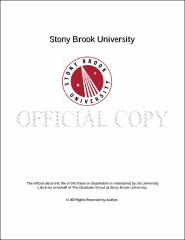| dc.identifier.uri | http://hdl.handle.net/11401/76870 | |
| dc.description.sponsorship | This work is sponsored by the Stony Brook University Graduate School in compliance with the requirements for completion of degree. | en_US |
| dc.format | Monograph | |
| dc.format.medium | Electronic Resource | en_US |
| dc.language.iso | en_US | |
| dc.publisher | The Graduate School, Stony Brook University: Stony Brook, NY. | |
| dc.type | Dissertation | |
| dcterms.abstract | My dissertation reveals the role of burlesque and humor in the feminist art of Martha Rosler. Rosler is acknowledged as a key figure in the feminist art movement, as well as a pioneer in video art, yet the fact that humor was integral to what I call her " feminist burlesque" --Rosler's parodic interpretation and re-presentation of the gendered imagery portrayed by the mass media--has been largely ignored in the literature surrounding her work. As such, this dissertation analyzes Rosler's feminist artwork from the 1970s that directly appropriated tropes of gender from the mass media and popular imagination in relation to both the extant body of literature, as well as the history of burlesque and the notion of a feminist aesthetic burlesque. I deliberately chose artworks that Rosler produced during the era in which the " second wave" of feminist activity crested, as these works not only reflect the role of the media in the construction of gendered identities, but also remain a poignant reminder of the media's continued dominance in representing tropes of femininity and masculinity, to this day. I selected artworks created by Rosler in which she directly engaged with the dominant tropes of gender portrayed within the media, as well. This dissertation asserts that Rosler's feminist burlesque of these tropes creates an aesthetic space for viewers to reconsider the role of the media, and the capitalist economy that supports and drives it, in constructing and confirming gendered identity, as well as the larger ideologies at play. I viewed Rosler's artwork through the lenses of carnivalesque laughter (Bakhtin), the history of burlesque, as well as Brechtian distanciation, and a feminist analytics of power (Scott). In doing so, this dissertation opened a new avenue for the analysis and discourse of feminist art and artists--that of the feminist burlesque. | |
| dcterms.available | 2017-09-20T16:51:21Z | |
| dcterms.contributor | Uroskie, Andrew V | en_US |
| dcterms.contributor | Bogart, Michele | en_US |
| dcterms.contributor | Patterson, Zabet | en_US |
| dcterms.contributor | Hesford, Victoria. | en_US |
| dcterms.creator | Kruglinski, Jennifer Mary | |
| dcterms.dateAccepted | 2017-09-20T16:51:21Z | |
| dcterms.dateSubmitted | 2017-09-20T16:51:21Z | |
| dcterms.description | Department of Art History and Criticism. | en_US |
| dcterms.extent | 236 pg. | en_US |
| dcterms.format | Application/PDF | en_US |
| dcterms.format | Monograph | |
| dcterms.identifier | http://hdl.handle.net/11401/76870 | |
| dcterms.issued | 2015-08-01 | |
| dcterms.language | en_US | |
| dcterms.provenance | Made available in DSpace on 2017-09-20T16:51:21Z (GMT). No. of bitstreams: 1
Kruglinski_grad.sunysb_0771E_12131.pdf: 1242338 bytes, checksum: 49e0978d11d90beed71e74fca5d32833 (MD5)
Previous issue date: 2014 | en |
| dcterms.publisher | The Graduate School, Stony Brook University: Stony Brook, NY. | |
| dcterms.subject | burlesque, feminism, laughter, photomontage, video | |
| dcterms.subject | Art history | |
| dcterms.title | Signal Disruptions: Gendered Tropes and the Feminist Burlesque of Martha Rosler | |
| dcterms.type | Dissertation | |

